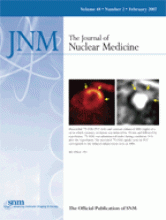The approval of new imaging agents has slowed, much as for therapeutic drugs. Schering and Amersham, for instance, each spent about $150 million a year for the period 1999–2004 on imaging agent research but did not get one new drug or significant indication approved in the United States as a result. This occurred at a time when the Food and Drug Administration has placed imaging in its Critical Path Opportunities list and when clinical PET has had double-digit growth. Will the opportunity be fulfilled and growth maintained using only currently approved radiopharmaceuticals? What will be the fate of new radiopharmaceuticals that appear in this journal? Their number shows no lack of potential candidates for commercialization—are they the wrong ones? What are the factors that influence bringing an imaging agent to commercialization and wide use?

Drug development costs are (too) high and getting higher. The current costs to develop an imaging agent are $100–$200 million over 8–10 y relative to therapeutic drugs, for which costs are $800–$1,700 million over 10–12 y. In contrast to the multibillion-dollar annual sales of a best-selling therapeutic drug, the annual sales of a best-selling imaging agent are in the $400 million range. Of the 10 or so imaging agents with annual sales over $200 million, 3 are radiopharmaceuticals, with the most recent approval in the United States having occurred more than 10 y ago. Current research and development costs are supported by revenues from drugs initially approved in the 1980s and early 1990s. All imaging agents are living off old successes.
The current prices that a company gets for each imaging dose will not support a new drug unless the use is heavy. A financial rule of thumb is that to begin development, a company must believe that peak-year sales will equal development costs—to support future research and to pay for failures. Radiopharmaceuticals currently exist in the commodity world of mature imaging agents separated principally on the basis of price, whereas new therapeutic agents are separated principally on the basis of value. Radiopharmaceutical reimbursement rates of $100–$200 per dose, if translated into revenue to the company, require a foreseeable annual use of 1 million doses. The market for myocardial perfusion agents is one such market, but a new agent must be better than approved drugs to capture the market share—Thallium has a significant use despite the availability of the technetium agents. A radiopharmaceutical designed to support the development of a therapeutic drug may not have any role after approval.
The major costs for developing all drugs, including radiopharmaceuticals, occur in discovery and in phase II/III and filing. Preclinical development and phase I do not constitute major costs, yet the most recent attempts by the regulatory authorities of Europe and the United States to “involve fewer resources than is customary” address only these areas with the microdosing or exploratory-investigational-new-drug concepts. Did they fix the wrong part? Whereas the discovery share of the total is large, it has remained stable over the years—because it is not regulated? Outsourcing/in-licensing discovery at best reduces risk for development companies because it is all borne by the smaller companies or academics (taxpayers!) but does not much reduce costs. The phase II/III and filing share has increased as a result of the increased requirements requested of drug companies by regulatory authorities and in anticipation of those from reimbursement groups. It might be said that molecular imaging is more complicated than, for example, “simple” perfusion and that this is driving up costs, but is this true and if it is how do we reverse the trend?
The design and execution of phase II/III trials must be improved to achieve faster, more efficient data collection and analysis. Clearer and wider understanding is needed by clinical sites that trials are not the practice of medicine and by the regulatory authorities and companies as to what is. The need to incorporate imperfect comparators or wait for outcomes is an issue. The position of the regulatory authorities on “defined clinical setting” is a key to the design; for example, is a target in one type of cancer the same as the same target in another type of cancer? FDG now has broad coverage in multiple cancer types but does not provide a useful model because it was developed outside industry, it was in experimental use for 20 y before approval, it did not undergo formal clinical trails, and a new drug application is not held by a drug company.
Imaging agents are undervalued, with a perception of little value but high price. What arguments can we make to show that today nuclear medicine provides high-quality care at too low a price? I believe the value of imaging to the community is perceived to be low relative to therapeutics yet in the era of personalized medicine they are all part of the same package. If radiopharmaceuticals are developed rapidly and cheaply and in large numbers to speed the development of therapeutic drugs, the Critical Path Initiative may be satisfied but new commercial imaging agents are not necessarily ensured. How do we persuade therapeutic drug companies and payers that imaging has a beneficial place with postapproval targeted therapeutics? The use of new radiopharmaceuticals to manage patient care after therapeutic drug approval requires an early partnership with therapeutic companies so that drug development is aligned. It also implies acceptance of a mechanism that may reduce patient numbers but treats the remainder better, the essence of personalized medicine. The alternative is that commercial radiopharmaceutical development will stagnate, with few new radiopharmaceuticals brought to the market.
Footnotes
-
COPYRIGHT © 2007 by the Society of Nuclear Medicine, Inc.







